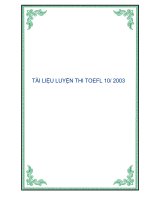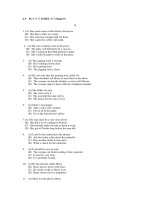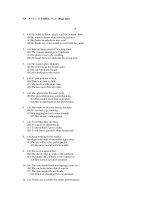TÀI LIỆU LUYỆN THI TOEFL 1/ 2004
Bạn đang xem bản rút gọn của tài liệu. Xem và tải ngay bản đầy đủ của tài liệu tại đây (56.27 KB, 19 trang )
2004 年 01 月 TOEFL 真题
Section One: Reading Comprehension
1. (A) She reads more slowly than the man does.
(B) She has a 1ot of material to read before she has coffee.
(C) The man does more work than is necessary.
(D) The man seems to be taking a long time preparing for philosophy class.
2. (A) The woman should have shown him the newspaper.
(B) He thinks the woman will win the contest.
(C) The woman's pictures are on top of the newspapers.
(D) The new photograph does not look anything like her others.
3. (A) Return his literature books to the bookstore.
(B) Keep his books from the literature class.
(C) Sell his literature books to the woman.
(D) Visit the reference section of the library.
4. (A) Give the secretary Janet's new address and phone number.
(B) Ask Janet a question about his health.
(C) Get information about Janet from the secretary.
(D) Visit Janet at her new school.
5. (A) She will help the man find the exhibit.
(B) She has already seen the exhibit.
(C) She will help the man read the map.
(D) She knows where to get a map.
6. (A) She is also planning to travel.
(B) She already picked up money for the trip.
(C) She has to study instead of traveling.
(D) She thinks the man should take more money.
7. (A) The woman should not get involved in the situation
(B) The woman should not be angry with he friends.
(C) He wants to talk to Sally and Mark.
(D) He will explain to the woman what happened.
8. (A) What travel plans Philip is making
(B) How Philip s parents are going to travel
(C) What Philip said
(D) Where Philip heard the news
9. (A) She will have to postpone her trip.
(B) She has already gotten her passport application.
(C) The passport office is closed.
(D) She was late in applying for her passport.
10. (A) He has not played tennis in a while.
(B) He does not know how to play tennis.
(C) His tennis racket is broken.
(D) He needs to rest before he plays.
11. (A) No one was interested in the discussion.
(B) Politics is a sensitive topic.
(C) The woman is not being serious.
(D) People avoided discussing politics.
12. (A) She already read the book.
(B) She will not lend her book to the man.
(C) The man can use her book whenever he likes.
(D) The man does not need the book.
13. (A) It is about to start raining.
(B) The rain will stop soon.
(C) It has been raining all day.
(D) It just stopped raining.
14. (A) She is not permitted to live off-campus this year.
(B) She has been living off-campus for a year.
(C) She is happy with her living arrangements.
(D) She is required to move next year.
15. (A) She misses her old roommate.
(B)She changes roommates often.
(C) She does not know Julie very well.
(D) She did not really enjoy living with Julie.
16. (A) Take a shorter route
(B) Buy new sun glasses
(C) Drive on a different road
(D) Consider using Route 27
17. (A) Give her ticket to the man
(B) Borrow some jazz music from someone else
(C) Go to the concert without the man
(D) Help the man to complete his paper
18. (A) Sullivan's has never been able to keep its chef.
(B) The service at Sullivan's is dependable.
(C) The quality of the cooking at Sullivan's is inconsistent.
(D) Customers get a lot of personal attention at Sullivan's.
19. (A) She thinks the wearier is pleasant.
(B) She has been working hard in the lab.
(C) She is not feeling very well today.
(D) She has been staying up quite late recently.
20. (A) The woman can wear it all winter.
(B) The woman may have trouble paying for it.
(C) It may not be warm enough.
(D) It will not fit if the woman loses weight.
21. (A) Introduce Michelle to the other reporters
(B) Take Michelle home
(C) Take a tour of the office
(D) Start working at his desk
22, (A) They should turn left when they see a stop sign.
(B) He does not have the directions with him.
(C) He does not see the stop sign yet
(D) He does not know which way to turn.
23. (A) Ho has not been to the new restaurant yet.
(B) He would like to go to the new restaurant with the woman
(C) The food at the new restaurant is not very good.
(D) A restaurant 's atmosphere is very important to him
24. (A) She is planning to drop the class.
(B) She thinks the man wants to take the class.
(C) She only has one class on Tuesdays and Thursdays.
(D) She has to leave for class.
25. (A) Ho does not feel very well.
(B) He had several teeth filled.
(C) The dentist gave him some medication.
(D) The woman is mistaken.
26. (A) Business courses have become popular
(B) The school only offers business courses.
(C) The business school has a new program.
(D) The school has just started to offer business courses.
27. (A) His alarm clock is broken.
(B) He bas been late before.
(C) H e prefers to study early in the morning.
(D) He worked in the lab last night.
28. (A) He will lend the woman moneyto buy a computer.
(B) The woman should wait a while before buying a computer.
(C) The woman should find a better way to invest her savings.
(D) The woman should buy a computer.
29. (A) There are none left.
(B) They are too expensive.
(C) They might be available at the concert.
(D) They need to be purchased in advance.
30. (A) She will go to the restaurant with the man.
(B) She will meet the man and his friends later in the evening.
(C) She has already had dinner.
(D) She will not change her original plans.
31. (A) A famous photographer
(B) Photographic processes in the 1800's
(C) Photographic equipment used in the 1800's
(D) A new museum
32. (A) Her subjects home
(B) Her subject's social status
(C) Her subject's personality
(D) Her subject 's role in history
33. (A) Backlighting
(B) Flashbulbs
(C) Time-lapse photography
(D) Soft focus
34. (A) Children
(B) Historical scenes
(C) Well-known people
(D) Landscapes
35. (A) Which major the woman will be choosing
(B) An anthropology course the woman is taking
(C) How to find a job in publishing
(D) Which anthropology professors the man recommends
36.(A) It is not as difficult as she had thought it would be.
(B)She would like her professor to explain it more clearly.
(C) She took a class on it last semester.
(D) Her professor will write a book on it soon.
37. (A) lt might lead to a job in publishing.
(B) It is being taught by a famous anthropologist.
(C) It will help her with her courses overseas.
(D) It will prepare her for future work in anthropology.
38. (A)Her professor
(B) A classmate
(C) Her former boss
(D) A foreign diplomat
39. (A) So they can feel its weight
(B) So they can examine its contents
(C) So they can guess its age
(D) So they can admire its beautiful color
40. (A) How amber changes shape when heated
(B) How clear amber is
(C) How common is around the world
(D) How easily amber can break
41. (A) Tropical insects
(B) Decayed leaves
(C) Tree resin
(D) Bird feathers
42. (A) Its amber contains numerous fossils.
(B) Its amber is the most durable.
(C) Its amber is opaque.
(D) It is the site of the oldest amber deposits.
43. (A) Amber mined from the Appalachian Mountains
(B) Amber with no imperfections
(C) Amber containing organic material
(D) Amber with no inclusions
44. (A) The difficulties faced by the colonists
(B) The skill of military heroes
(C) The courage of one man
(D) The cause of the Revolutionary War
45. (A) He did not fight in the Revolution my War.
(B) He did not really exist.
(C) He was an important town leader.
(D) He was not the only messenger.
46. (A) It was well planned.
(B) It was completed in a short time.
(C) It was led by military commanders.
(D) It helped him get elected to public office.
47. (A)To explain how angles are measured
(B) To prove that Mesopotamiansdid not know how to use square numbers
(C) To discuss a mistaken historical interpretation
(D) To explain why tablets are reliable historical records
48. (A) They did not use square numbers.
(B) They used complex measuring instruments.
(C) They recorded math exercises on tablets.
(D) They calculated the length of triangle sides.
49. (A) Pictures of triangles
(B) Calculations using square numbers
(C) Measurements of angles
(D) Greek symbols
50. (A) They taught the Mesopotamians about square numbers.
(B) They were less advanced in mathematics than the Mesopotamians.
(C) They did not use square numbers.
(D) They knew how to measure angles.
Section Two: Structure and Written Expression
1. The ancestors of the horse lived ..... and were about half a meter tall.
(A) years ago 60 million
(B) 60 million years ago
(C) ago 60 million years
(D) million years ago 60
2. The museum on Ellis Island, a former immigration station, contains documents and
artifacts......to four centuries of United States immigration.
(A) related them
(B) related
(C) related that
(D) be related
3. ......, particularly the oxides of sulfur, greatly increases the rate at which rust forms.
(A) The presence of air pollutants
(B) Air pollutants are present
(C) Because the presence of air pollutants
(D) Air pollutants whose presence
4. The Sun, the Moon, and Earth have magnetic fields, and......evidence that the stellar that extend
through vast regions galaxies have fields of space.
(A) which is
(B) is
(C) because
(D) There is
5. The “confederation school” poets of nineteenth-century Canada were primarily nature poets,
----- a wealth of eulogies to Canadian rural life.
(A) and producing
(B) who they produced
(C) producing
(D) whose production of
6. Since prehistoric people first applied natural pigments to cave walls, ---- have painted to
express themselves.
(A) when artists
(B) artists
(C) artists who
(D) that artists
7. About 42 million bushels of oats are used annually --- manufacture of breakfast foods in die
United States.
(A) the
(B) is the
(C) in the
(D) to
8. Any acid can, in principle, neutralize any base, although .......between some of the more
reactive compounds.
(A) side reactions can occur
(B) the occurrence of side reactions can
(C) can side reactions occur
(D) side reactions that can occur
9. Just over two-thirds of Earth’s surface is covered by wafer, ...... more than 98 percent of this
water is contained in the oceans.
(A) with
(B) which
(C) and
(D) resulting
l0. Pleas ing to look at and touch, beads come in shapes, colors, and materials .......to handle and to
sort them.
(A) that almost compel one
(B) one compels
(C) that compel almost
(D) one is almost compelled
11. In 1978 the united States National Air and Space Administration selected Sally Ride.......the
first woman astronaut.
(A) who being
(B) to be
(C) and being
(D) was
12. Adhesions are ....... formed within the body in response to inflammation or injury.
(A) that thin bands of scar tissue
(B) they thin bands of scar tissue when
(C) thin bands of scar t issue
(D) thin bands of scar tissue able to
13. The planet Neptune is about 30 times ...... from the Sun as Earth is.
(A) far
(B) as far
(C) more far
(D) far that
14. Not until the 1850's ...... a few public-spirited citizens and state legislatures seek to rescue
historic buildings in the United States from destruction or alteration.
(A) both
(B) came
(C) did
(D) when
15. ----- 200 bones forming the framework, or skeleton, of the human body.
(A) Being over
(B)There are over
(C) Where over
(D)Over
16. The world's water balance is regulated by the constant circulation of water in
A B C
Liquid and vapor tom among the oceans, the atmospheric, and the land.
D
17. The major purpose of the United States Department of Education are to ensure
A
equal educational opportunity for all and to improve the quality of education.
B C D
18. Massive gains in computer speed, power, and reliably have been largely due
A B C
to advances in silicon tec~logics and manufacturing processes.
D
19. The sunflower, the official state flower of Kansas, and is widespread in
A B
the prairies of the western United States.
C D









